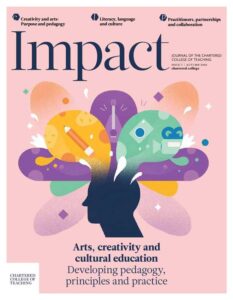Using immersive storytelling as a tool for developing compassion and cultural capital

Please note, the author of this article is Director of Engagement at Lyfta, the subscription-based resource for schools described in this case study.
We live in an increasingly connected world. Many of our children are growing up exposed to greater diversityThe recognition of individual differences in terms of race, ethnicity, gender, sexual orientation, socio-economic status, physical ability, religious beliefs and other differences than ever before, through direct contact with people around them, as well as via the various media channels with which they interact daily. Many of our inner-city schools boast over 30 different spoken languages, making daily life a rich tapestry of experience, culture, religion and language (von Ahn et al., 2010). However, our world also reflects a society that is increasingly polarised, affected by ‘popularist’ messages of intolerance, suspicion and stereotyping. It seems that it is not enough to live side by side. We need to engage compassionately with the human experience of our fellow citizens if we are to be able to find creative and humane solutions to the problems in the world. The case studies that follows looks at how one online resource was used in educational settings to help students understand others and improve their knowledge and understanding of diversity.
Lyfta is an award-winning Finnish education resource (Education Alliance Finland, 2018), which has been developed based on educational research that suggests immersive storyworld experiences have potential to support learning (Immordino‐Yang and Damasio, 2007; Jenner, 2014). Within Lyfta, children are able to visit real homes, workplaces and environments around the world that have been created as 360-degree explorable spaces. Children can click on the things they see there and learn more about the places they visit. In each space there is also a person they can click on and ‘meet’, who comes to life in a short, three-to-five-minute documentary.
Lyfta has been exploring the way in which schools use the platform to tackle complex, challenging concepts around culture and identity. One secondary school in Essex started using Lyfta because of a PSHE teachers’ concern with the rising levels of nationalism in the area and the attitudes of her students. The students at the school were mainly from white British heritage, and had had little opportunity to experience people from diverse backgrounds or the world beyond their local area. This was a key missing component in their cultural experience that the school wanted to address in a sensitive yet powerful way.
We developed a survey based on the work by Simon Baron-Cohen on the Empathy Quotient (EQ) (Lawrence et al., 2004), which the students took before and after exploring the storyworlds. EQ is a psychological self-report measure of empathy developed by Simon Baron-Cohen and colleagues at the Autism Research Centre at the University of Cambridge. EQ is based on a definition of empathy that includes cognition and affect.

At the start of our project, the students surveyed were asked to consider six faces of people whom they would meet over the course of their exploration of the storyworlds (see Figure 1). The students were asked whether they believed that they had common ground or empathy with them (weighted from strongly agree to strongly disagree).
In this first survey, students said that they felt they had most in common with persons 1, 4 and 6 – who were all white and looked most like them, in their experience.
After exploring the different environments and watching a short documentary featuring each of the people in the pictures, they were asked to respond again to the question about common ground. The students felt that they had more in common with all of the people, and in particular those that had scored lower in the first survey – persons 2, 3 and 5. Most remarkable was the shift in affinity with person number 5. This 56-year-old Palestinian taxi driver became their favourite person that they learned about. The children were keen to know whether they might be able to meet him in real life one day.
Through this simple and powerful exercise, the teacher was able to start an important conversation with her students around difference, bias, diversity and more. She was able to provide them with an engaging experience and saw the impact on their attitudes, which could have a lasting effect (Immordino-Yang and Damasio). If we are to change hearts and minds, we cannot simply ‘teach and tell’ students about the world, or oblige them to understand the importance of human experience. The teacher summarised by saying, ‘I had a conversation with one student who felt very challenged by the whole experience with Lyfta. He said he now felt he needed to never judge someone before getting to know them and understanding their current situation. It was great to see that Lyfta had had such an impact on all 30 of my students, but particularly one boy.’
A teacher at a special school for 11–19-year-olds in Manchester has also used immersive storyworlds to aim to improve empathy and understanding of the world is among children with autism. This teacher used the immersive storyworlds and 360-degree environments with her class of children on the autistic spectrum up to 12 hours a week for the course of a year via laptops, virtual reality (VR) headsets and an interactive whiteboard. Although she said that she was sceptical about her pupils watching foreign documentaries and reading subtitles, by the end of the year she saw remarkable changes in their abilities, attitudes to and engagement with learning. What she also didn’t anticipate was the levels of empathy the children had, not only for the human subjects of the immersive storyworlds, but also for each other. She commented that ‘the traditional teaching methods for subjects like history or geography can be too abstract and even irrelevant for some students. However, the immersive experience has enabled them to begin to understand people more and it has helped them to start to notice, compare and discuss what they think, as never before.’ This certainly resonates with research carried out around immersive technologies, such as virtual reality, augmented reality and 360-degree immersive environments (Mannion, 2018).
This article is from one of the connecting-classrooms.britishcouncil.org programme training providers. Connecting Classrooms through Global Learning participants from state-funded schools who successfully complete Lyfta’s global learning course at lyfta.com/CCGL can receive complimentary access to the Lyfta learning platform for two years.
References
Education Alliance Finland Report (2018) (formerly Kokoa Standard) Lyfta: An interactive documentary platform for social, Global Education and literacy studies. Available at: https://educationalliancefinland.com/products/lyfta (accessed 17 July 2019).
Jenner C (2014) Navigating distant worlds: International development and social change in interactive web documentary. <em>Global Times</em>. Available at: https://ojs.mau.se/index.php/glocaltimes/article/view/85 (accessed 17 July 2019).
Immordino‐Yang MH and Damasio A (2007) We feel, therefore we learn: The relevance of affective and social neuroscience to education. Mind, Brain, and Education 1(1): 3–10. Available at: https://onlinelibrary.wiley.com/doi/full/10.1111/j.1751-228X.2007.00004.x (accessed 17 July 2019).
Lawrence EJ, Shaw P, Baker D et al. (2004) Measuring empathy: ReliabilityIn assessment, the degree to which the outcome of a particular assessment would be consistent – for example, if it were marked by a different marker or taken again and validityIn assessment, the degree to which a particular assessment measures what it is intended to measure, and the extent to which proposed interpretations and uses are justified of the Empathy Quotient. Psychological Medicine 34: 911–919. Available at: http://docs.autismresearchcentre.com/papers/2004_Lawrence_etal_MeasuringEmpathy.pdf (accessed 17 July 2019).
Leatham J (2018) How VR is helping children with autism navigate the world around them. Available at: www.vrfitnessinsider.com/how-vr-is-helping-children-with-autism-navigate-the-world-around-them (accessed 17 July 2019).
Mannion J (2018) Growth headset? Exploring the use of VR and AR in schools. Available at: iscdigital.co.uk/growth-headset-the-report (accessed 17 July 2019).
von Ahn M, Lupton R, Greenwood C et al. (2010) Languages, Ethnicity, and Education in London. Department of Quantitative Social Science – Institute of Education, University of London, DoQSS Working Papers.
The Empathy Quotient Tests are available from the Autism Research Centre at https://www.autismresearchcentre.com/arc_tests
This article was published in September 2019 and reflects the terminology and understanding of research and evidence in use at the time. Some terms and conclusions may no longer align with current standards. We encourage readers to approach the content with an understanding of this context.










